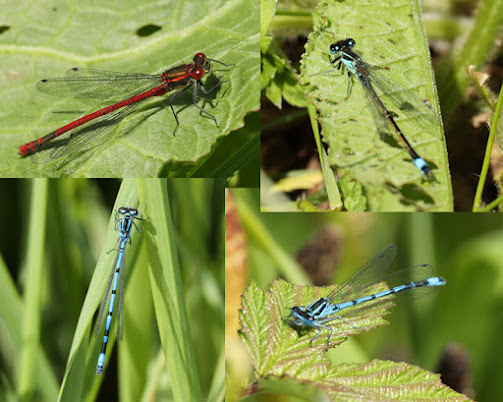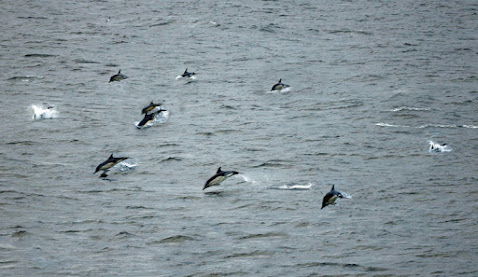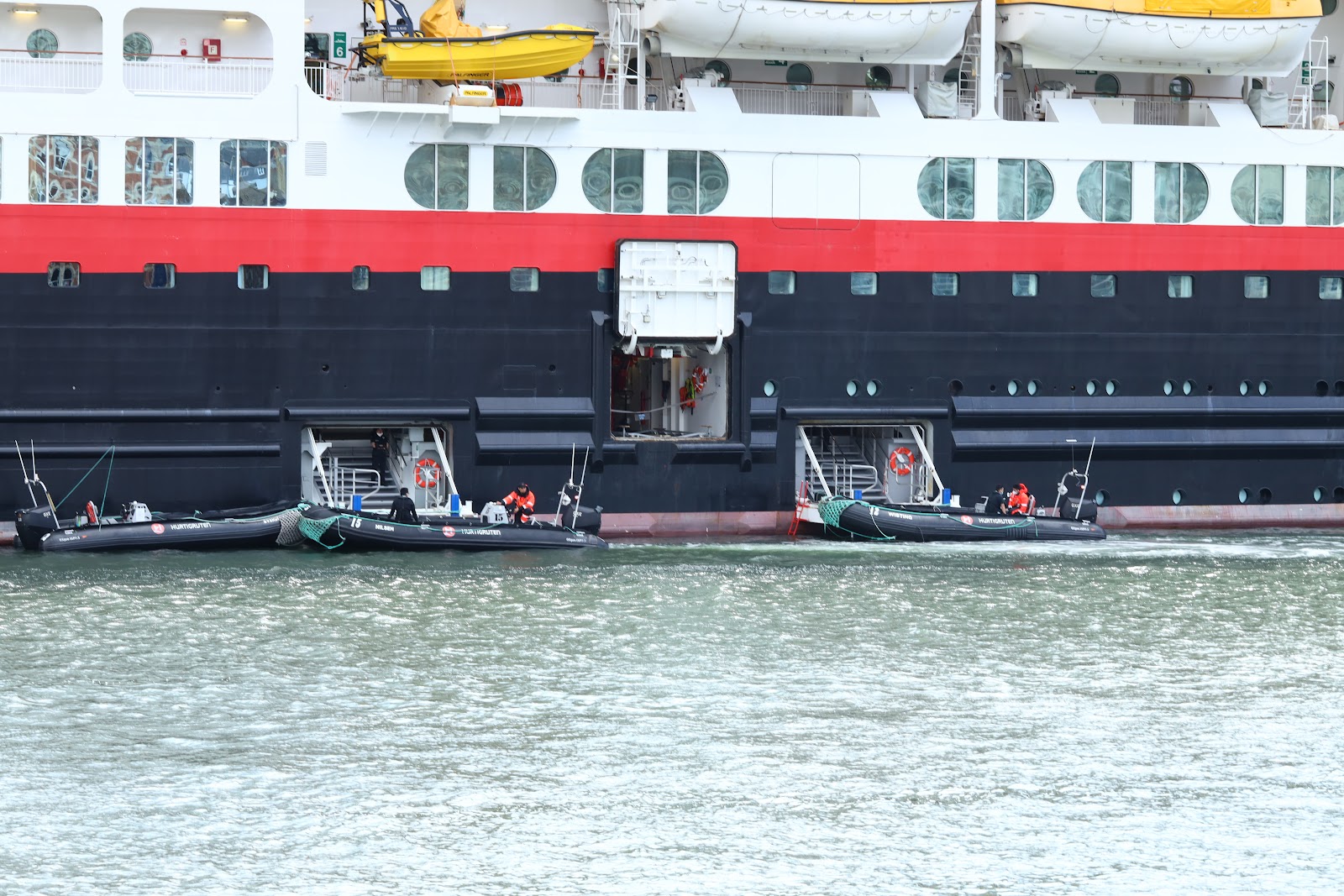We took a slow cruise past the Calf of Man and then down the Irish coast and arrived next morning at Waterford famous for it's crystal glass but we found the nearest Taxi and headed out to Dunhill to the Anne Valley Wildlife Walk, a 5km walk along a beautiful river valley. What is really good is the path is suitable for everyone even if you have a disability so it was ideal for Jackie, though we realised she wouldn't manage the whole 5km. Though in fact because the path was flat and level and there were seats nicely spaced along the route we did a little more than we anticipated.
Unfortunately the little cafe was closed only open at weekends but we had a sunny warm day and we headed off along the path quickly checking off Sedge Warbler and Reed Bunting and as we continued on we slowly checked off all the common species including a swimming Grey Heron.
The best find of the day must go to Jackie when she saw an Otter in one of the ponds and we had brief views when it dived and disappeared. Jackie and Fran walked on but David and myself backtracked and re-found it in another of the adjoining ponds.
 |
| Dog Otter - Anne Valley Walk - © Nick Hull |
 |
| Large Red, Blue-tailed and Azure Blue Damselflies Anne Valley Walk ˙ Nick Hull |
We had a good number of butterflies and both dragon and damselflies and lots of other inverts but I must admit we made an error and we didn't realise until at the end of our walk. Whilst waiting for our Taxi and talking to a couple of local birders who had lead the cruise group along the full walk that the white butterflies we were seeing were Cryptic Wood White and a butterfly lifer for us.
As always we could have spent much more time here but alas we had to leave. Our next destination was the Isle's of Scilly in fact Tresco. We are probably one of a few birders that have never been to the islands which have been renown for rarities particularly in the autumn. So we were very interested in seeing one of the islands even if it was only for a few hours.
As was the norm we caught one of the ribs and were transported to the jetty dumped our lifejackets and checked out the information sign and decided to walk to the Abbey Tropical Gardens. En-route we were greeted by lots of Rock Pipit they seemed to be everywhere.
 |
| Rock Pipit - Tresco Isle of Scilly © Nick Hull |
A little way on I spotted a wheatear which looked very upright and in the sunlight looked a tad pale I took a few shots but Jackie wanted to move on I took another shot or two and joined her and continued on tothe gardens. In fact we walked past the entrance probably because our attention had been drawn by a pair of Shelduck with young, the male was attacking another duck which was possibly a female Pochard. We never did find out as when it was attacked it dived and when eventually it surfaced and straightaway flew off low around the lake side vegetation out of sight.
 |
| Wheatear - Tresco possibly female Greenland race - Nick Hull |
After a while we realised our error and back tracked and found the entrance to the Tropical gardens where we introduced ourselves to the gatekeeper this very hungry Red Squirrel.
 |
| Red Squirrel - Tresco © Nick Hull |
We lunched at the Islands cafe before we explored the gardens. We saw very few birds but the it was a very good insight to the Island and it's wildlife.
 |
| Views of the Tresco garden © Nick Hull |
On the way back to catch the rib back to the MS Maud we added Stonechat and more Rock Pipit, we also had another look at the Wheatear and saw Common Blue and Green Tiger beetle.
Again we didn't have a great wildlife list but it was great to visit the island and get a feel for the Isles of Scilly and we will return sometime to investigate some of the other islands.
Our next stop wasn't going to be an Island but a visit to Dartmouth where we took a trip up the river which added another Grey Seal or two and we had Peregrine fly over and surprisingly a lone Egyptian Goose on the riverbank both species additions to our list.
 |
| The MS Maud and Dartmouth as we sail up river |
 |
| Dartmouth Artillary fortalice © Nick Hull |
Back in 1336 when the Hundred Year War between Britain and France started to guard against French invasion in 1388 Richard II ordered the mayor of Dartmouth to build a Fortalice and so the building in the top photograph was duly built.
By the middle of the 15th century England was still at war with the French and the townsmen of Dartmouth strengthened their defences by building another artillery tower which was completed by Henry the VII around 1493. It contained the winding mechanism for a river chain which was secured close to a defensive tower at Godmerock on the opposite bank. (lower photo).
Of course Dartmouth is also reknown to this day as having the training college for Naval Officers.
Though not very wildlife orientated we had a very nice visit but we were soon back crossing to MS Maud for our last Rib ride as this would be our last destination before getting off at Dover and the completion of our Expedition Cruise with Hurtigruten.
Throughout the holiday most mornings and evening a small group of the passengers and the on-board Cetacean expert Tony and Ornithologist Simon, David, Fran, Jackie and myself plus a couple of other passengers would meet at the front of deck 6 looking over the bow and seawatching. Over the holiday we managed to see a few things over, in and on the sea.
Apologies for the terrible photograph but this was probably the first highlight of the trip as we were passing Cornwall on our first day. I spotted this summer plumaged Great Northern Diver unfortunately it was to far out from the ship for my 100-400 lens.
 |
| Distant Great Northern Diver |
 |
| Gannet from the bow of MS Maud © Nick Hull |
We would sometimes see a flock resting or feeding, sometimes we would then see Dolphin appear under them.
 |
| Feeding Gannet seen from the MS Muad © Nick Hull |
 |
| Gannet passing the ship heading to the nesting colony © Nick Hull |
Over the course of the holiday we were lucky on a few evening usually late evening when we saw several super pods of Common Dolphin on three occasions numbers were in excess of 100 animals.
 |
| Common Dolphin heading towards the ship © Nick Hull |
Another species which we saw on most seawatch's were Manx Shearwater on one occasion as mentioned in the earlier blog we had a very large flock resting on the sea off Cornwall.
 |
| Manx Shearwater © Nick Hull |
 |
| Northern Fulmar © Nick Hull |
Of course when we were sailing around the Hebrides we encountered the odd skua our first was a Dark-phase Arctic skua that passed very close to the bow of the ship which gave excellent views.
 |
| Dark-phase Arctic Skua © Nick Hull |
On a couple of occasion we also had Great Skua cruising by though we saw most when we were visiting the islands, sea bird colonies.
 |
| Great Skua © Nick Hull |
Another species that we occasionally saw at sea were Kittiwake though not so many as you would think you might see.
 |
| 1st/summer and Adult Kittiwake © Nick Hull |
Also when we were approaching islands which had large seabird colonies we would see various auk species and the various gull species, sometimes they would fly close pass the ship.












